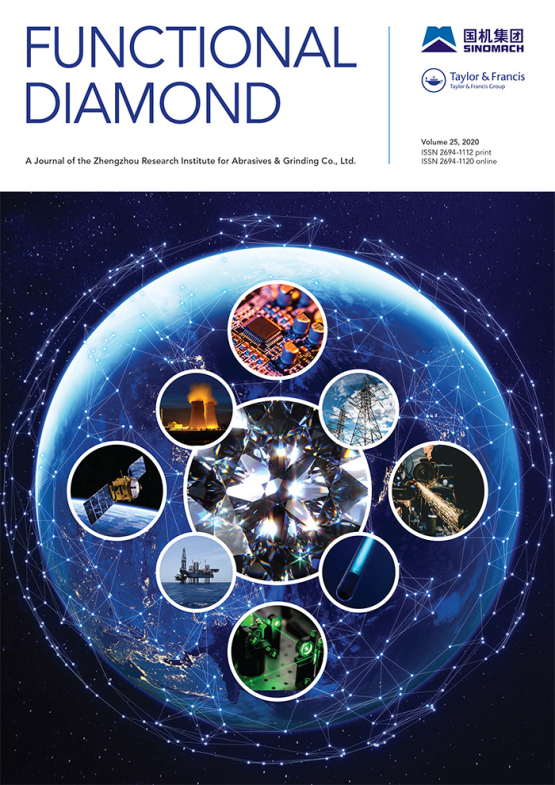Submit a Manuscript to the Journal
Functional Diamond
For an Article Collection on
Precision Diamond Synthesis: in Situ Diagnostics, Doping Control, Functional Devices, and Emerging Applications
Manuscript deadline


Article collection guest advisor(s)
Dr. Victor Ralchenko,
Prokhorov General Physics Institute of the Russian Academy of Sciences, Russia
vg_ralchenko@mail.ru
Dr. Paul May,
University of Bristol, UK
Paul.May@bristol.ac.uk
Precision Diamond Synthesis: in Situ Diagnostics, Doping Control, Functional Devices, and Emerging Applications
Synthetic diamond crystals, films, and nanoparticles are attracting increasing interest due to their exclusive electronic, optical, thermal, and mechanical properties, which are highly desirable for applications such as high-frequency/high-power diodes and transistors, sensors, radiation detectors, optical thermometry, and quantum devices etc. To fully exploit diamond’s potential, improved control over its growth process is essential, enabling precise tuning of crystal structure, purity, doping levels, and surface morphology. Therefore, precise in situ control of the growth environment (plasma chemistry), including substrate temperature stability, growth rate, surface topography, doping level, and isotopic purity, is essential to ensure a highly stable or programmable deposition process, which serves as a prerequisite for achieving high-quality material. Advanced in situ diagnostics, such as laser interferometry, optical emission spectroscopy, and laser absorption spectroscopy, are critical to optimizing diamond-based functional devices and accelerating their adoption in emerging applications.
The performance of diamond components and devices depends critically on purity, spatial uniformity, defect density, stress, and doping efficiency. For example, low-dislocation materials are required for competitive diodes, radiation-hard photon/particle detectors, Raman lasers, and narrow-line single-photon emitters based on color centers. Similarly, sharp interfaces between doped and intrinsic layers are decisive for achieving delta-doping with superior electronic properties. Highly stable growth process during tens or even hundreds of hours is mandatory to produce bulk single crystals with axial and lateral uniform structure. An improved understanding of the relationship between growth parameters and the resulting crystal/film structure, along with refinements and innovations in growth equipment and process control, enables new possibilities for developing next-generation diamond-based devices and novel applications. This Article Collection serves as a platform for sharing state-of-the-art research and perspectives to advance diamond technologies for specific applications.
Topics of interest include, but are not limited to:
- CVD diamond growth with enhanced in situ process control (e.g., laser interferometry/absorption, optical emission spectroscopy, and Raman spectroscopy) and novel diagnostics;
- Modelling of plasma chemistry, flow patterns, and growth dynamics;
- Precise doping control, delta-doping, and sharp interfaces;
- Ultrapure diamond, atomically smooth surfaces, and surface engineering;
- Advanced characterization methods for single-crystal, microcrystalline, and nanocrystalline diamond;
- Diamond-based devices: electronics, optoelectronics, sensors, MEMS, nanothermometers, quantum devices, etc;
- While this collection primarily focuses on CVD diamond technologies, high-quality researches on HPHT (high-pressure high-temperature) diamond synthesis and applications also fall within the scope.
We welcome original research articles, reviews, and perspectives exploring the latest developments in diamond with well-controlled properties for emerging applications.
Keywords: Diamond synthesis; In situ diagnostics; Growth control; Functional devices; Novel applications
All manuscripts submitted to this Article Collection will undergo a full peer-review; the Guest Advisor for this Collection will not be handling the manuscripts (unless they are an Editorial Board member).
Please review the journal scope and author submission instructions prior to submitting a manuscript.
The deadline for submitting manuscripts is [30 April 2026].
Please contact [Zhan Yu] at [zhan.yu@taylorandfrancis.com] with any queries and discount codes regarding this Article Collection.
Please be sure to select “Precision Diamond Synthesis: in Situ Diagnostics, Doping Control, Functional Devices and Emerging Applications” from the drop-down menu in the submission system.
Victor Ralchenko received his MS degree in quantum electronics in 1976 from Moscow Institute of Physics and Technology, and Ph.D. degree in physics from General Physics Institute of Russian Academy of Sciences (GPI RAS), Moscow, in 1989. Currently he is the head of Diamond Materials Laboratory at GPI RAS and professor at Harbin Institute of Technology, China. He is the author of over 400 contributions in peer-reviewed scientific journals, 2 books, 6 book chapters, and 11 patents. His research interests mainly focus on CVD diamond synthesis and characterization, and diamond applications in electronics and photonics.
Benefits of publishing open access within Taylor & Francis
Global marketing and publicity, ensuring your research reaches the people you want it to.
Article Collections bring together the latest research on hot topics from influential researchers across the globe.
Rigorous peer review for every open access article.
Rapid online publication allowing you to share your work quickly.
Submission Instructions
All manuscripts submitted to this Article Collection will undergo desk assessment and peer-review as part of our standard editorial process. Guest Advisors for this collection will not be involved in peer-reviewing manuscripts unless they are an existing member of the Editorial Board. Please review the journal Aims and Scope and author submission instructions prior to submitting a manuscript.
